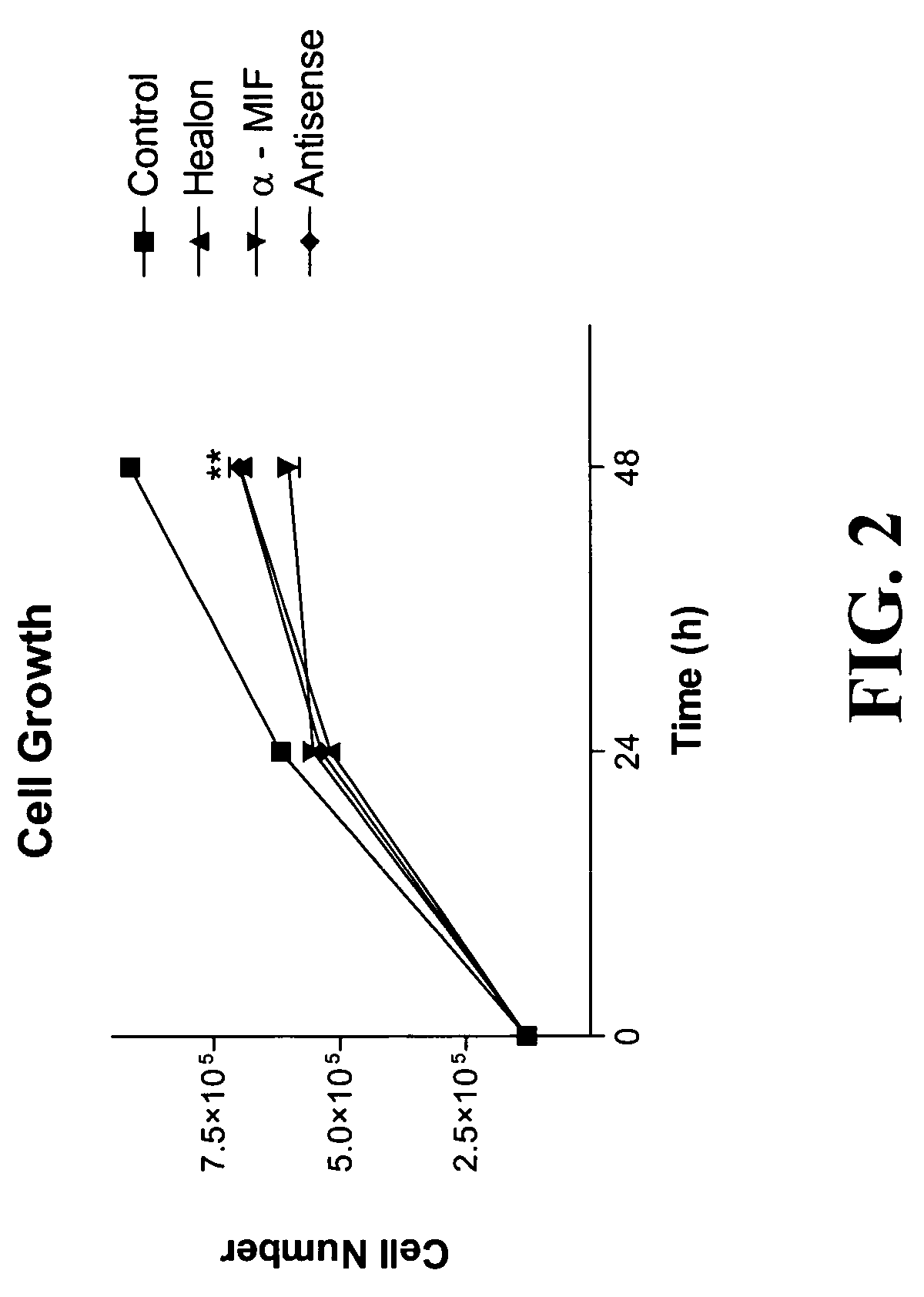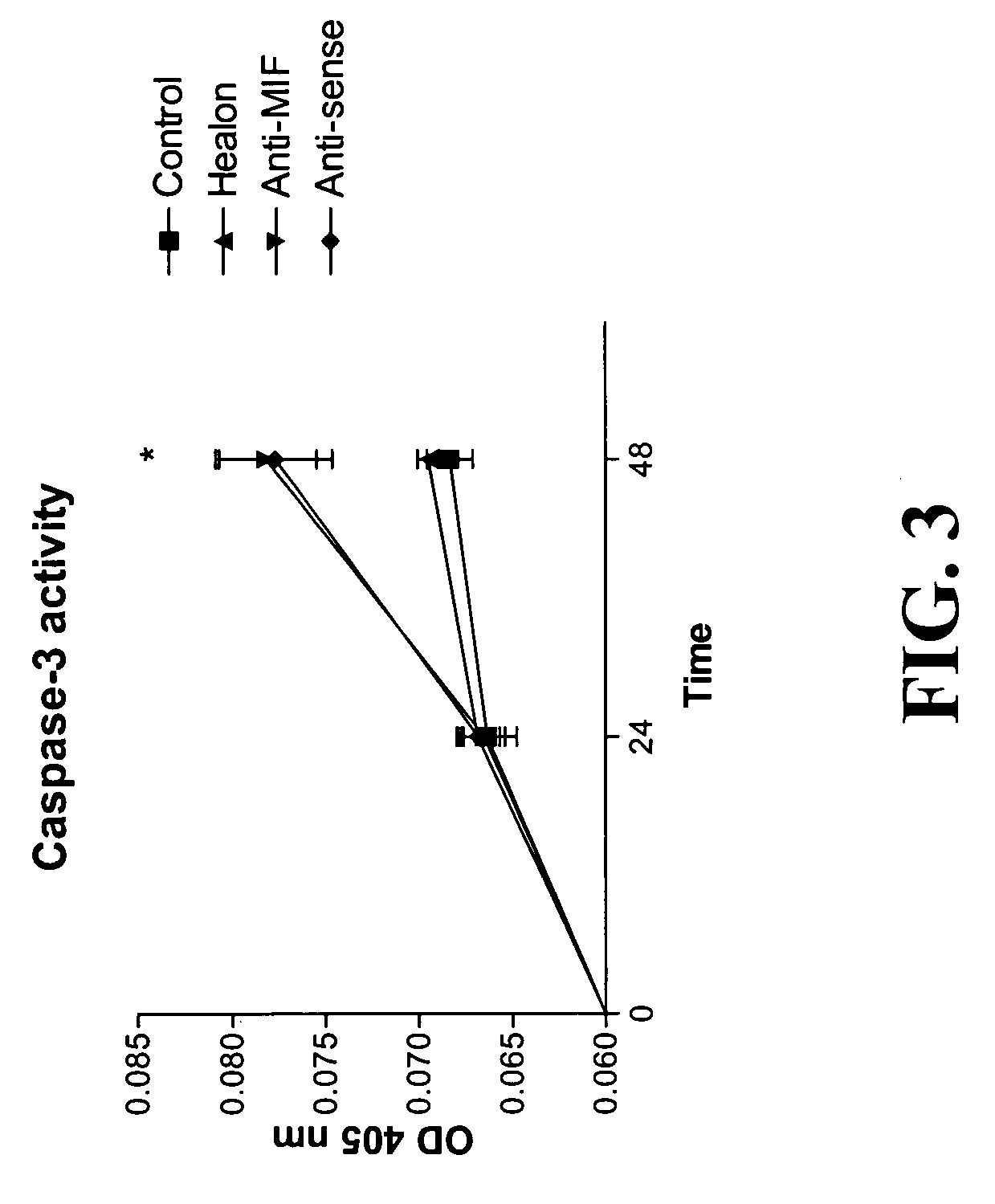Methods for diagnosing and treating bladder cancer
a bladder cancer and cancer technology, applied in the field of bladder cancer diagnosis and treatment, can solve the problems of inability to detect small cancers, insufficient treatment, expensive procedures, uncomfortable patients, etc., and achieve the effect of attenuating tumor growth
- Summary
- Abstract
- Description
- Claims
- Application Information
AI Technical Summary
Benefits of technology
Problems solved by technology
Method used
Image
Examples
example 1
Human Bladder Adenocarcinoma Cells Synthesize and Secrete MIF In Vitro
[0038] In order to establish the relevance of MIF to urogenital disease in humans we sought to determine if human bladder epithelial cells secrete MIF. Human bladder HT-1376 cells (ATCC, Manasas, Va.) were cultured for 48 hours and the culture medium was assayed for MIF using ELISA. In addition, intracellular content of MIF was assayed from cell lysates. These human bladder adenocarcinoma cells synthesize MIF (226±0.6 μg / mg protein). The average MIF concentration secreted into the medium by these cells was 15 ng / ml. Expression of MIF was confirmed by RT-PCR analysis. Thus establishing MIF secretion by human bladder epithelia.
example 2
IHC / Insitu
[0039] The intracellular location of MIF protein and mRNA in the normal human bladder and prostate was determined by immunohistochemistry and in situ hybridization. Four-micron thick sections were processed for immunohistochemistry using an anti-human MIF antibody (R&D Systems, same antibody that is used for detection in the ELISA) and a standard peroxidase-antiperoxidase protocol. The location of MIF mRNA within these tissues was determined by insitu hybridization. MIF specific templates are prepared by reverse transcription of total RNA from a human bladder cell line (HT-1376) followed by amplification of a MIF 254 bp fragment (nucleotides 67-321). T7 RNA polymerase promoters were ligated to the resulting PCR product and biotinylated single stranded RNA oligonucleotide probes prepared from this template by in vitro transcription. Paraffin embedded tissue is prepared for hybridization by dewaxing through xylene, followed by hydration through alcohol and Proteinase K dige...
example 3
Intravesical MIF Blockage Alters Bladder Cancer Cell Growth and Cytokine Expression
[0040] Bladder transitional cell carcinoma cells secrete MIF into the culture medium, therefore it is possible that MIF release is participating in a regulatory loop that amplifies or maintains bladder cancer cell growth. We determined whether it was possible to disrupt this loop by neutralizing MIF. Preliminary data from experiments performed on rats determined that intravesical MIF antibody reversed changes in gene expression (Disclosure VA IP 03-079). In addition intravesical MIF antibody reduced histological signs of bladder inflammation. Our hypothesis is that MIF may be involved in the initiation or the continuation of inflammatory and growth-promoting processes, which are essential to tumor growth; therefore, blockade of MIF may be able to prevent or reverse bladder cancer.
[0041] In these experiments we chose three different mechanisms of MIF inhibition. A non-specific MIF inhibitor, Healon (...
PUM
| Property | Measurement | Unit |
|---|---|---|
| Level | aaaaa | aaaaa |
| Inhibition | aaaaa | aaaaa |
| Luminescence | aaaaa | aaaaa |
Abstract
Description
Claims
Application Information
 Login to View More
Login to View More - R&D
- Intellectual Property
- Life Sciences
- Materials
- Tech Scout
- Unparalleled Data Quality
- Higher Quality Content
- 60% Fewer Hallucinations
Browse by: Latest US Patents, China's latest patents, Technical Efficacy Thesaurus, Application Domain, Technology Topic, Popular Technical Reports.
© 2025 PatSnap. All rights reserved.Legal|Privacy policy|Modern Slavery Act Transparency Statement|Sitemap|About US| Contact US: help@patsnap.com



